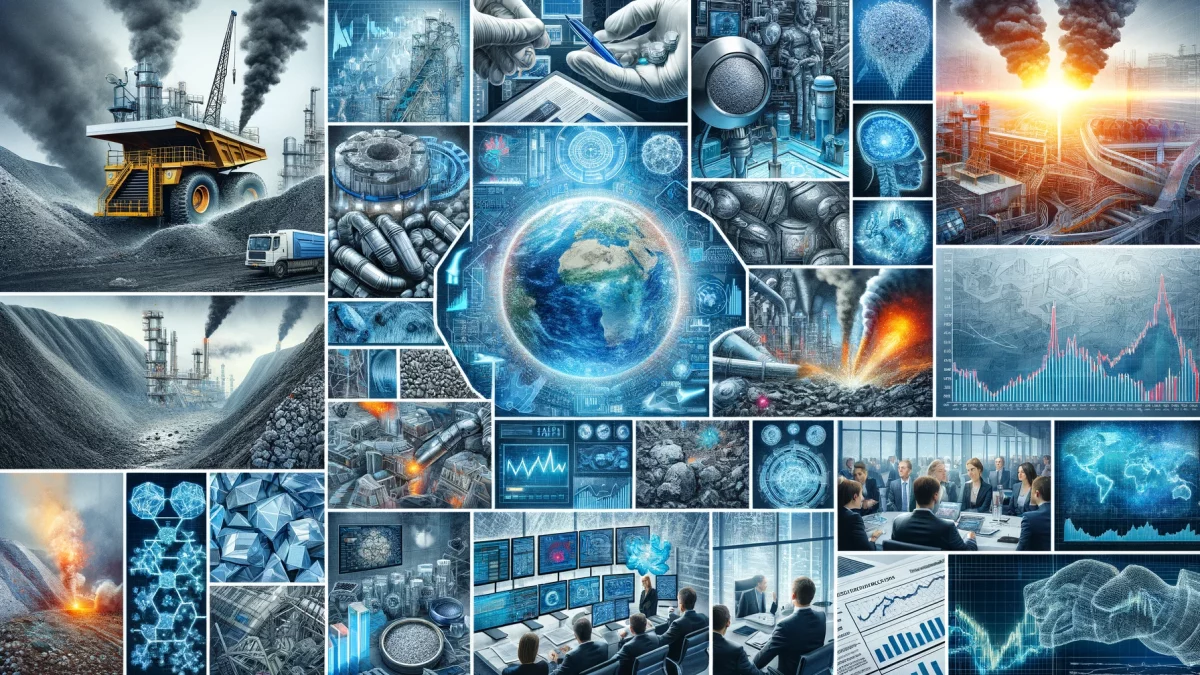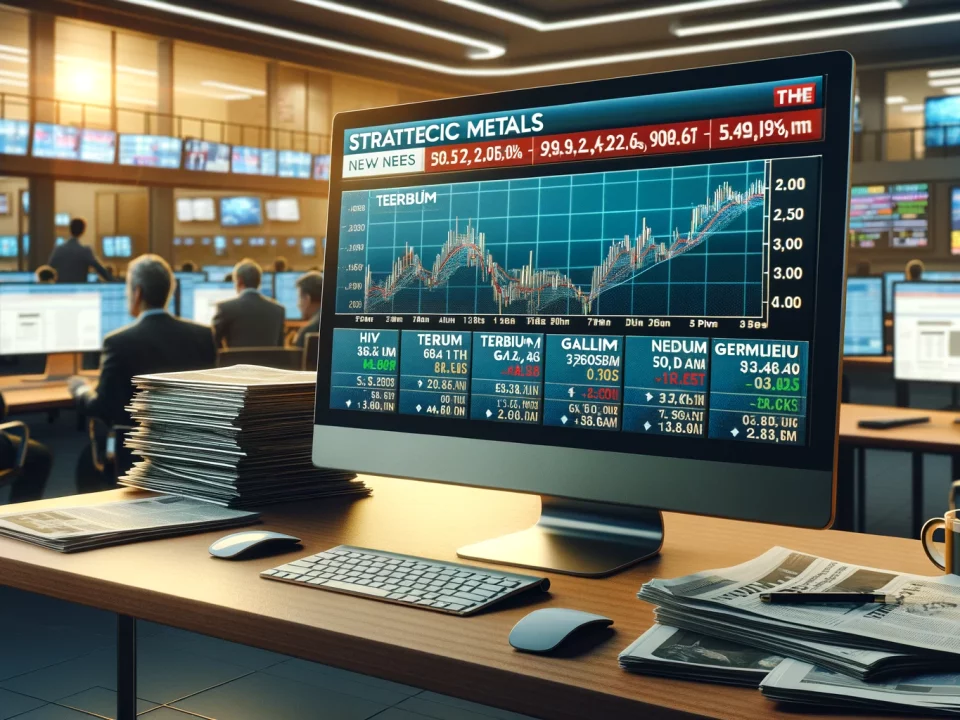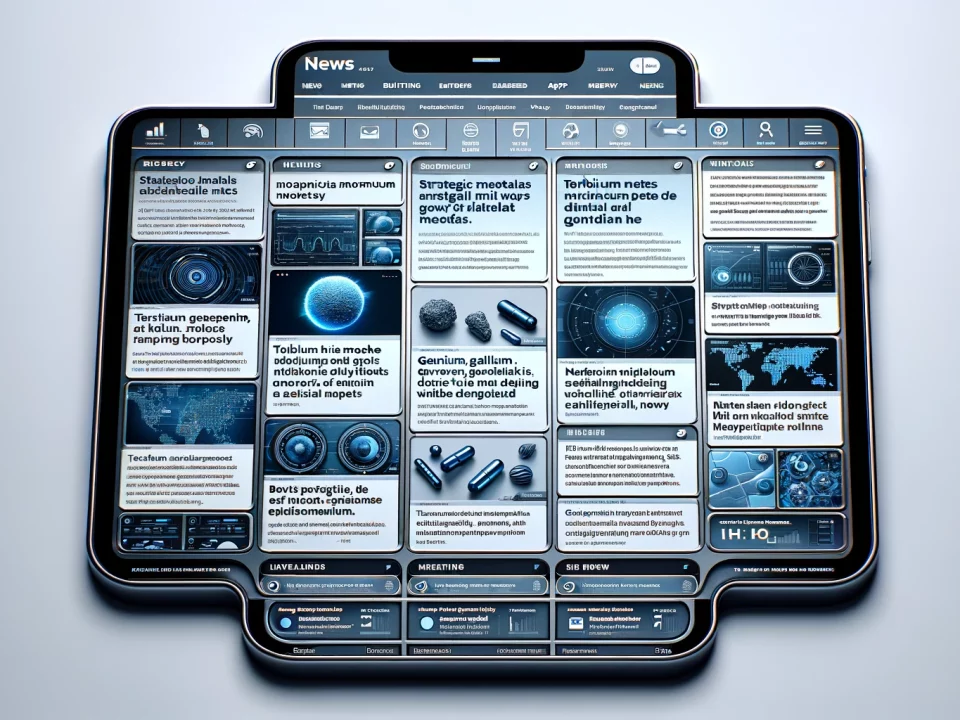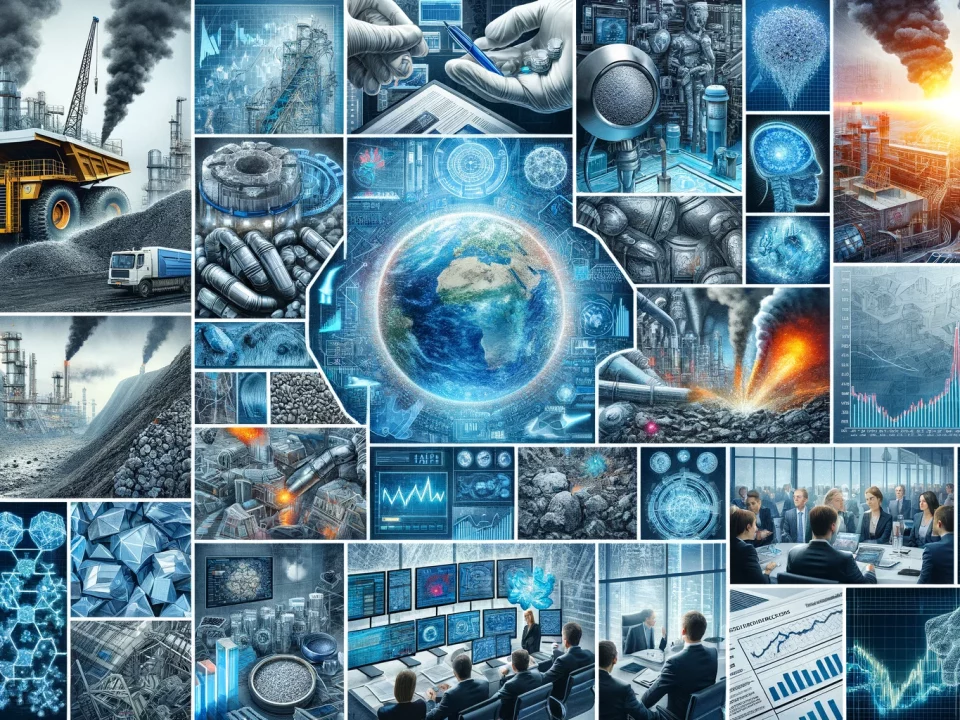
Weekly News Review Mar 4 – Mar 10 2024
March 10, 2024
Weekly News Review Mar 18 – Mar 24 2024
March 24, 2024Welcome to our weekly news review,
DEEP-SEA MINING: US LAWMAKERS SET TO PROPOSE A NEW BILL.
The proposal aims to ramp up nodule collection in the deep sea, domestic processing, and refining critical minerals.
U.S. lawmakers seek to accelerate American deep-sea mining activities in a new bill introduced on Tuesday, the Wall Street Journal (WSJ) reports.
According to the WSJ, the proposal pushes explicitly for financial, diplomatic, and infrastructure support for the industry, which has exclusively seen a draft text of the bill. Sponsored by Rep. Carol Miller (R., W.Va.) and Rep. John Joyce (R., Pa.), the aptly named Responsible Use of Seafloor Resources Act seeks to advance U.S. nodule collection in the deep-sea, as well as domestic processing and refining of critical minerals, where “upstream sourcing is compliant with regulations.” Miller added that the act would bolster U.S. supply chains while creating numerous jobs.
Deep-sea mining has gained traction globally in recent years as countries pursue diversification efforts in critical minerals supply chains, which China currently dominates.
In Norway, for example, the parliament approved government plans to open up an area in the North Atlantic to explore and extract mineral sources earlier this year. However, despite the promising potential of creating new sources of raw materials, deep-sea mining faces opposition from environmental groups and some governments. Germany, France, Switzerland, Chile, and the UK are among the most vocal proponents of a moratorium on issuing permits until the environmental impacts have been studied and are better understood.
ALTERNATIVE TO CHINA? NEW SUPPLY CHAINS FOR RARE EARTH MAGNETS.
South Korean Posco Group will supply car manufacturers in North America and Europe. Raw materials are to come from the U.S., Australia, and Vietnam.
Posco International, the trading and energy division of South Korean steel giant Posco, will supply car manufacturers in North America and Europe with permanent magnets made from rare earths. Corresponding contracts worth around $885 million have been signed via Posco’s subsidiaries in the U.S. and Germany, as reported by The Korea Herald, among others. According to the Group, the rare earths used to produce the permanent magnets will come from the United States, Australia, and Vietnam. All three countries want to establish themselves as raw material alternatives to quasi-monopolist China, although Vietnam’s rare earth industry is still in its infancy. The People’s Republic dominates the extraction of critical minerals and their further processing into permanent magnets.
Posco did not name the customers; the delivery period in the USA is expected to be from 2026 to 2031 and in Europe from 2025 to 2034. The Star Group, Korea’s only manufacturer of these high-tech components, will produce the permanent magnets. Last fall, plans were announced to build a magnet factory in the U.S. together with Posco.
Other South Korean industries and government representatives are also developing new supply chains to reduce dependence on Chinese raw material imports and strengthen the domestic industry. For example, Vietnam recently agreed on closer bilateral cooperation, including research on rare earths. Just over a month ago, the South Korean company LS Cable & System also announced a joint venture with Vacuumschmelze, Europe’s leading producer of permanent magnets.
ARAFURA SCORES BIG WITH $533 IN GOVERNMENT FUNDING.
The Australian company’s Nolan project aims to be the country’s first ore-to-oxide mine and processing facility.
According to a company statement, the Australian rare earth exploration and mining company Arafura has secured a total of $533 million in funding from the Australian Government for its Nolans project in central Australia. With financial support, Arafura and the government aim to catalyze the venture and provide transparent funding and debt requirements.
Arafura aims to construct Australia’s first combined rare earth ore-to-oxide mine and processing facility with Nolans. The project will produce neodymium-praseodymium oxides in its facilities. These oxides are used to manufacture permanent magnets, which are employed in electric vehicle motors and wind turbines. Most rare earth raw materials extracted in Australia are shipped abroad to be refined. Fellow Australian rare earth miner Lynas has been shipping its raw material to Malaysia, for example, but has recently commissioned a domestic processing facility in Australia’s south-west.
Arafura emphasized that Nolans will bolster the country’s critical minerals supply chains, aligning with Australia’s Critical Minerals Strategy unveiled last year.
Offtake agreements for the rare earths produced in Nolans have already been concluded with South Korean carmakers Hyundai and Kia and Spanish-German wind energy company Siemens Gamesa.
SOLAR CELLS IN YOUR EYE? – GALLIUM’S ROLE.
Researchers are working on gallium-based photovoltaic implants that could be used to treat diseases such as macular degeneration.
One of the most common causes of blindness is the degeneration of photoreceptors, the cells that regulate the perception of light and color. This is usually triggered by diseases such as retinitis pigmentosa or widespread age-related macular degeneration. Neuroprosthetics – devices that interact with the nervous system to restore lost functions – could offer a therapeutic approach.
One well-known example is the cochlear implant for deaf and hearing-impaired people, which converts sound into electrical signals. An international group of researchers at the University of New South Wales in Australia is now working on making this principle usable for people with sight loss.
They rely on photovoltaics: tiny solar panels convert the light entering the eye into electrical impulses and transmit the visual information to the brain without involving the damaged photoreceptors. The device could even supply itself with electricity, explains one of the researchers involved, Dr Udo Roemer, a significant advantage because, unlike electrodes, for example, no wires or cables would be needed in the eye.
Gallium as the Material of Choice: Potential Advantages for Eye Implants:
Solar cells for restoring vision are already being researched, says Roemer. However, instead of silicon, the most common photovoltaic material to date, he and his team are concentrating on other semiconductor materials, such as gallium arsenide and gallium indium phosphide, as the properties of these materials are easier to control. The industry uses them to produce so-called thin-film solar cells; compared to the market-dominating thick-film modules made of silicon, they are much lighter and could achieve higher efficiency in the future. In 2021, the Fraunhofer Institute ISE made headlines with a gallium arsenide solar cell that reached a record efficiency of almost 69 per cent.
The design of these solar panels also speaks for a possible use in vision loss, as gallium arsenide is much easier to layer than silicon, according to Roemer. Several layers are necessary to generate sufficient voltage to stimulate the neurons. In addition, (smart) glasses could be required to work together with the solar cells and amplify the light signal.
According to Roemer, research is currently in the proof-of-concept phase, which serves to demonstrate basic feasibility. Laboratory tests to date have gone well, but there is still a long way to go before the technology can be implanted in the retinas of people with degenerative eye diseases.
USGS PUBLISHES STRATEGIC METALS SUMMARIES 2024:
The report provides an overview of more than 90 commodities.
The U.S. Geological Survey published its annual Mineral Commodity Summaries, the first comprehensive overview of the production and demand for mineral commodities in the past year. The annual publication is also dedicated to resource policy and provides essential information on the global reserves of more than 90 commodities, excluding fuels such as coal and natural gas.
In 2023, raw materials worth 105 billion US dollars were produced in the USA, an increase of four per cent compared to 2022. Nevertheless, the data now presented shows the country’s heavy dependence on imports, particularly for gallium, indium, scandium yttrium, and eleven other commodities.
The most important countries of origin—representing imports of more than 50 per cent of a particular raw material—are China, Canada, Germany, Brazil, Belgium, Mexico, Russia, and South Africa. For example, the USA covers 100 per cent of its demand for the alkali metal caesium through imports from Germany, which is also a major supplier of rubidium and other technology metals to the USA.
The USGS has also published new estimates of the volume of rare earth deposits in the most important countries of origin, including a downward revision of the US’s own estimates. The adjustments are particularly significant for Russia, which, according to the agency, now has reserves of 10 million tons instead of 21 million tons. According to the calculations, Australia’s reserves are more extensive than previously assumed. This is good news for the country, which is increasingly seeking to establish itself as an alternative to industry leader China.
CANADA PROMOTES CONSTRUCTION OF A RARE EARTH PROJECT: A KEY STEP IN THE VALUE CHAIN –
Support pledged for “most environmentally sustainable plant in the world”. Canada wants to compete with the raw materials giant China through efficiency and sustainability.
Canada’s government will provide the equivalent of almost 4.5 million US dollars to support the construction of a domestic processing plant for rare earths in Saskatoon.
The first of its kind in North America, it will be operated by the state-funded research and technology organisation Saskatchewan Research Council.
Although the critical raw materials have recently been mined in Canada, further processing has mainly taken place in China, which has a near-monopoly on this technology.
The investment will be used to develop a process for separating and commercialising rare earth oxides from radioactive monazite tailings that would otherwise have been dumped.
Monazite is one of the most essential ores for extracting rare earths.
According to the government, the new process could provide additional raw materials for producing up to 65,000 electric vehicles annually.
Mike Crabtree, president and CEO of the Saskatchewan Research Council, said that in addition to profitability, it would also improve the sustainability of the plant, which he told the CBC was the most environmentally sustainable in the world.
The funding will also contribute to developing an automated metal smelting process. Crabtree said this efficiency is important to compete with China.
CBC writes that the plant is expected to go into operation at the end of this year. The construction of the rare earth plant has already received millions in funding from various government organisations.
Setbacks on Canada’s Path to Becoming a Leading Producer of Raw Materials.
Canada, which is rich in natural resources, wants to evolve into a leading producer of critical raw materials and has presented a comprehensive strategy to this end.
This also includes stricter controls on investments by foreign state-owned companies – primarily China – in the domestic minerals sector. Nevertheless, cooperation with Chinese companies continues to make headlines; in October, Shenghe Resources bought shares in Vital Metals, the owner of Canada’s only rare earth mine, Nechalacho.
Like the Saskatchewan Research Council, Vital Metals was also planning to build a processing plant for rare earths, but had to put this project on hold due to a lack of economic viability.
EU WANTS TO INCREASE COOPERATION WITH GREENLAND.
EU Commission President Ursula von der Leyen visited Greenland on Friday. One of the most important concerns of her state visit was the supply of critical raw materials.
In order to strengthen cooperation in this area, the EU has opened its first office on the Arctic island. Danish Prime Minister Mette Frederiksen accompanied Von der Leyen; Greenland is a self-governing territory of the Kingdom of Denmark and, although not part of the European Union, is considered one of the hopes for securing raw materials for the bloc. The island is rich in natural resources, including 25 of the 34 raw materials the EU categorises as critical and strategic, such as rare earths, writes the British newspaper The Guardian.
Demand for these minerals is growing, primarily due to their use in electric motors and wind turbines; a study by Belgium’s KU Leuven in 2022 showed that Europe’s demand alone could increase up to 26-fold by 2030. There are currently no mines for rare earths on the continent, despite some large deposits, and only a few plants for processing the raw materials.
Sustainable Value Chains: Raw Materials Partnership at Eye Level Planned.
Cooperation is therefore crucial, the Guardian quotes Tomas Baert, Special Advisor to the President of the European Commission for Trade and International Partnerships. He emphasizes that the EU wants to promote domestic value creation. Naaja H. Nathanielsen, Greenland’s Minister for Economic Affairs, Trade and Raw Materials, says Greenland needs bilateral cooperation and investment to further develop its mineral sector and diversify its economy, which is currently mainly dependent on fishing.
The EU recently signed a partnership with the island to create sustainable raw material value chains in compliance with environmental, social, and governance standards. The importance of this point was demonstrated in 2021 by the opposition to the Kvanefjeld rare earth project, leading to the break-up of the Greenlandic government. Local residents feared the release of radioactive uranium, which can occur as an accompanying mineral in rare earth deposits. The new government set limits for uranium concentrations at the end of 2021, leaving the future of Kvanefjeld uncertain.
However, this is not affected by the Sarfartoq project, which is still in the development stage. The rare earth metals mined there could be processed into components for wind turbines or electric cars by the operator Neo Performance in Estonia, where Europe’s most crucial refinery is located.






